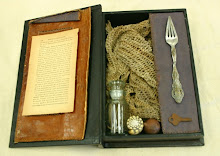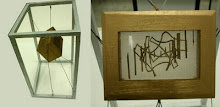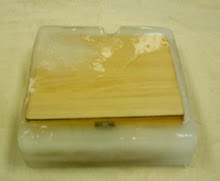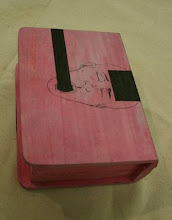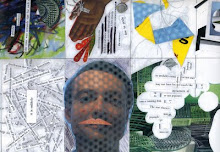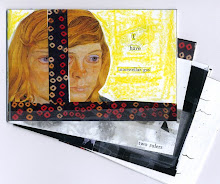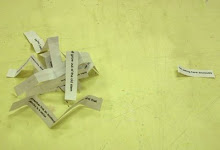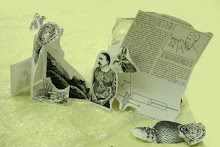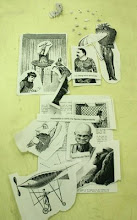In this project students were introduced to the work of poet Marianne
Moore and artist Joseph Cornell and asked to look for ways the artifacts
they made (poems and boxes, respectively) suggested similarities in
theme or practice. The visual art students were then asked to create
work that responded to Moore or was Moore-like in some way, and the
writing students were to create work that responded to Cornell or was
Cornell-like. Here are a few examples:
Hannah Brown:
Jessica Dueker:
Danica Isaacs:
Katie Tuttle:
Krystyny Vandenberg:
Michael Hall:

Jared Sumners:
HOMETOWN SCHOOL
Taking his wife through old school grounds, the man points, explaining the importance of things.
That used to be a concrete bench whose grinding wax permanently stained both the man’s jeans, but he kept sitting there for lunch everyday because that’s where his friends met.
The man only went to that cafeteria on Wednesday, for chilidog day.
He played guitar on that stage for some event.
That window was perpetually boarded up.
Those were science buildings, he thinks.
That smell that she smells comes from the ag. department, upper campus. Ag. kids mostly stayed up there, and the smell had not been appreciated, but the man always wanted to join them in their pins with the animals. Something social kept him.
Which reminds him, that’s the band room. The senior prank involved writing intimate secrets on the larger brass instruments. One baritone read: “look at me I’m in band, I like music, and Sarah Peterson.” Sarah Peterson was a girl who hung out with teachers. The man had loved playing trumpet, but stopped playing when it became weird to, which was early on.
The man shows his wife the door of the nurse’s office. Inside there’s yellow carpet and yellow wallpaper, multiple countries’ versions of dolls, and two semi-inspirational posters. Her desk had many photos of her family. Actually, he noted, after looking in the window, it’s different now, probably a different lady.
That field there was not usable. It was reserved for baseball. The other field was for everyone else.
The “Y” on the hill was incredibly hard to get to. We almost died trying to get to it. We hated the hills then, because they were for running not for looking. They’ll change colors next month.
At the end of the annex road there’s a store that sells soda exclusively. There’s enough root beer varieties to have a different kind every day of the school year, if he remembers. There was a carnival-prize sized bear inside, for seating.
Driving away, the man points to a Wendy’s that used to be a Taco Tia’s where that guy had tried to fight him.
He rolls down the window. Their a/c doesn’t work.
His wife reminds him she grew up there too.
Megan Van Vlear:

Hayley Langdon:
Olivia O'Brien:
A world of blue and white
holds curious creatures
that walk on water. 'Neath
a whitewashed wooden sky
they float,
aligned with
the same blue moon,
that with the flick of
a finger, move across
this world of water and sky.
"Navigaget in me, please,"
he asks, waiting for a
touch; a movement. Earth, space,
wait - God-made hand made God.
Alessi Debartolo:
Jill White:
Robert Heckert:
Robert Brown:
Found Poems based on Color Key to North American Birds, by Frank M. Chapman and Chester A. Reed (Published in 1903). Inspired by the Art of Joseph Cornell (Born in 1903).
Owls: Pages 140-143
Cinnamon brown. Top of head streaked. Above
Bright rusty brown. Frequently repeated
Tremulous, wailing whistle. A slower
Refrain-like call. Castanet-like snapping
Of the mandibles. Begins slow and ends
Rapidly. Cha-cha, cha-cha. Coo, coo, coo.
Rarely a hair-raising scream. Ear-tufts small.
Nape, tufts of scapulars, neck band rusty.
Flanks, legs, and feet more rufescent. Paler
Ashy. I have seen only a grey phase.
Herons: Pages 92-94
White, about fifty straight “aigrette” plumes grow
From the back between the wings. Legs blackish.
Lower back, wings and tail ashy. Outer
Webs of primaries, pale rufous. Rattling
Oc-oc-oc-oc-oc. An explosive quawk.
Range—Tropical and temperate. Very
Rare in eastern North America. What
Is supposed to be a gray-blue phase has
Been called Ardea wuerdmanni, a bird
Which resembles number one-ninety-four.
Jordan Wilson:
Sharayah Hooper:
Jenna Schmidt:
Destiny Gough:
Megan Brady:
Hope Daley:

Abby Blake:
Claddagh Ring
When I was 15, I went to Ireland with my grandmother for the first time. One of our outings took us to the Museum of Country Life in Castlebar, about an hour from where she lived in a village outside Westport in County Mayo. I do not remember anything specific about the museum itself beside it being situated next to a manmade lake and containing the anticipated displays depicting things related to the countryside of west Ireland. But I do remember the gift shop. It was an austere white room full of shiny trinkets and decorations, a few guidebooks, and a number of accessories. A spinning display rack to the left of the check-out counter hosted a collection of jewelry, including different styles of the claddagh symbol: banded hands holding a crowned heart. My grandma had mentioned she would buy my mom and I each a claddagh ring, a tradition she had started with her daughters during their first trip to her native land. My mom and I both picked silver ones, hers containing a bejeweled heart that made the ring look slightly large. Mine lacked the large gem, being just a simple representation of the design. I placed it on my left pointer finger, and sought to wear it consistently.
When my cousin Greg married his wife Stacy, I learned something about my claddagh ring. I had never sought out information of what wearing one meant beyond a tradition within my family. After the ceremony, when my female relatives and I were all fawning over one another's outfits, my cousin's new wife Stacy noticed my ring and showed me her own, which she kept on her right thumb. Teasingly, she asked who my special somebody was since I wore the ring with the heart upright, meaning the tip of the heart pointed toward my knuckle. I told her no one, and she then informed me that wearing it in that direction means you are taken, while sporting it upside-down means you are single. A little embarrassed, I digested her information and switched the direction of my ring around when no one was looking.
When I first came to college, I embarked on a consistent spree of losing my ring to the bowels of my dorm-issued dresser. Not once, but three times did I look down to realize it was missing and start to despair over losing something that had become significant to me. The first time I misplaced it, I forgot I had put it inside the pocket of a pair of shorts along with a few other pieces of jewelry. I had searched everywhere I could think of for it until I had given up and started looking online for a replacement. Then one day I happened to pull out that pair of shorts and put them on, noticing the pocket felt odd as I slid them on. I peaked inside to find my missing ring and quickly canceled my order for a new one. The second time I "lost" it, I found it again while putting away laundry. The bottom drawer of my dresser overflowed with sweats and other warm clothes, and I determined to take them all out and put them back in a more organized way as well as add the clean clothes to the space. While removing them, I heard a soft ping against wood, and saw my ring spinning to stop in the bottom of the drawer. I again put it back on. The third time I noticed my ring missing, I was once again in the process of putting away laundry. I had just shoved my clothes into the once more overflowing bottom drawer and saw that my ring was no longer on its finger. This time I checked said drawer first, and found it in the space my hand had previously forced some sweats in to. Since then, I removed my ring when dealing with clothing.
When I overcame my fear of the always-crowded caf, it too became a place my ring loved to wander off my finger. The first time, I felt it fly off my hand as I enthusiastically gestured about something to a friend. My conversation stopped, and I instigated an investigation of our immediate surroundings. We were seated at the first long table near the salad bar, where a wall divides the food area from the tables. After looking under and on top of our sitting area (as well as the begging other diners to look below their feet for just a sec), I ventured to the other side of the dividing wall, not expecting anything positive. However, here I found my ring, having flown about seven feet from where I originally sat, over a wall, to rest on the tiled floor beneath the salad bar. I was relieved. The next time I did not distinctly notice the moment it slipped off my finger, but remembered the last place I recalled wearing it, which happened to be the caf, where someone had asked about it at breakfast. Upon returning for lunch, I asked the front kiosk and, to my surprise, a worker had found it and placed it in a small black box reserved for ID cards. Here I realized I probably could not permanently lose this ring if I tried.
When an opportunity for midnight ice-skating came around, I decided to forgo sleep and enjoy myself. A friend of mine from Oregon showed me and some others how to skate towards a person, link arms with them, and spin around. I was successful in performing this trick, at first, until my friend Megan and I attempted it. We had gained a little too much confidence in our newfound skill and skated toward one another too fast. Instead of spinning, we whipped around each other, the side of her skate landing on my fingers. We laughed it off, but the next morning claddaghed-finger was slightly swollen and purple. I took off the ring to examine my finger and noticed the band had bent from its circular shape to have a straighter right side, perfectly fit to the actual shape of my finger. I only maintained an annoyance for its imperfect shape for a short time, as I soon realized it no longer slid around or off my finger whenever it pleased. It has since preferred to stay on my finger, and taking it off takes more effort than putting it on.
Saturday, February 27, 2016; 2:40 p.m. to 3:42 p.m.



















































































































